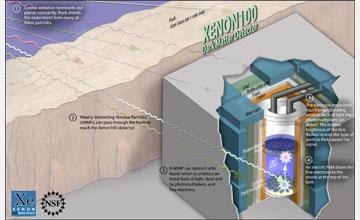All Images
News Release 11-074
Search for Dark Matter Narrowed by New Data From XENON100
Collaboration reveals results from 100-day experiment
This material is available primarily for archival purposes. Telephone numbers or other contact information may be out of date; please see current contact information at media contacts.

1) The surface of the Earth is constantly bombarded by cosmic radiation. Only the most energetic particles penetrate the rock, so detectors aiming to "see" the rare signal from cosmic Dark Matter are placed beneath the Earth.
2) Dark Matter in the form of Weakly Interacting Massive Particles (WIMPs) can traverse the Earth without interacting with it to reach XENON100, a detector filled with liquid xenon that is designed to be sensitive to such rare encounters.
3) A WIMP interaction in the liquid xenon will excite atoms and free electrons, which will be picked up again swiftly by the atoms. Both processes produce a flash of light that can be detected by photomultipliers, which act as extremely sensitive cameras, at each end of the tank.
4) An electric field running through the detector prevents some of the electrons from recombining with the xenon atoms. These free electrons are pushed upwards towards the anode, an electrode through which electric current flows, until they reach the liquid-to-gas interface.
5) At the interface, a stronger electric field pulls the electrons out of the liquid into the gas, where they create another flash of light that is detected by the same photomultipliers. The brightness of this second flash compared with the first one reveals the type of particle that caused the signal.
The XENON collaboration consists of 60 scientists from 14 institutions in the U.S.
(Columbia University, N.Y.; University of California Los Angeles; and Rice University,
Houston), China (Shanghai Jiao Tong University), France (Subatech Nantes), Germany
(Max-Planck-Institut für Kernphysik Heidelberg, Johannes Gutenberg University Mainz, Westfälische Wilhelms-Universität Münster), Israel (Weizmann Institute of Science), Italy (Laboratori Nazionali del Gran Sasso, INFN e Università di Bologna), Netherlands (Nikhef Amsterdam), Portugal (Universidade de Coimbra) and Switzerland (Universität Zürich).
Credit: Zina Deretsky, National Science Foundation
Download the high-resolution JPG version of the image. (602 KB)
Use your mouse to right-click (Mac users may need to Ctrl-click) the link above and choose the option that will save the file or target to your computer.
Dark matter has so far foiled most means of detection, but researchers are continuing to pursue its mysteries. They're using the most sensitive detector yet, called XENON100, to try to glimpse the particles. See how it works in this video.
Credit: National Science Foundation
Tom Statler of NSF's Astronomy Division explains why we want to study dark matter and dark energy.
Credit: National Science Foundation


